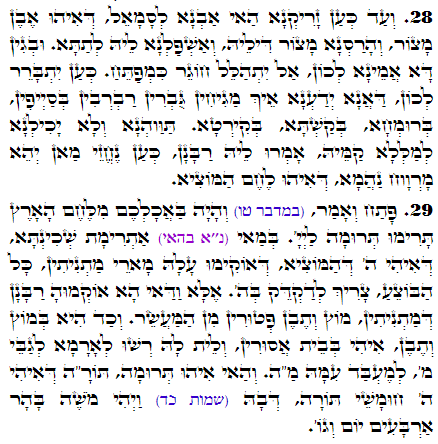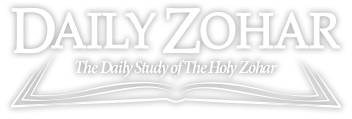Daily Zohar # 2503 – Ekev – How to kick out the uninvited
Daily Zohar 2503
Daily Zohar 2503

.
Hebrew translation:
29. פָּתַח וְאָמַר, (במדבר טו) וְהָיָה בַּאֲכָלְכֶם מִלֶּחֶם הָאָרֶץ תָּרִימוּ תְרוּמָה לַה’. בַּמֶּה נִתְרֶמֶת שְׁכִינָה, שֶׁהִיא ה’ שֶׁל הַמּוֹצִיא, שֶׁבֵּאֲרוּ עָלֶיהָ בַּעֲלֵי הַמִּשְׁנָה, כָּל הַבּוֹצֵעַ צָרִיךְ לְדַקְדֵּק בַּהֵ”א? אֶלָּא וַדַּאי הֲרֵי פֵּרְשׁוּהָ רַבּוֹתֵינוּ שֶׁל הַמִּשְׁנָה, מוֹץ וְתֶבֶן פְּטוּרִים מִן הַמַּעֲשֵׂר. וּכְשֶׁהִיא בְּמוֹץ וְתֶבֶן, הִיא בְּבֵית הָאֲסוּרִים, וְאֵין לָהּ רְשׁוּת לְהָרִים לְמ’ לַעֲשׂוֹת עִמָּהּ מָ”ה. וְזוֹהִי תְּרוּמָה, תּוֹרָ”ה שֶׁהִיא חֲמִשָּׁה חֻמְשֵׁי תוֹרָה, שֶׁבָּהּ (שמות כד) וַיְהִי מֹשֶׁה בָּהָר אַרְבָּעִים יוֹם וְגוֹ’.
.
Zohar Ekev
Continued from previous DZ 1894 and DZ 2502
#28
The Yenuka connects the previous study about the five words/stones as a weapon. He used it against the head of the negative side, Sam-el. He tells his guests, sages of the Zohar, that with his ‘stone’ that is the aspect of the Torah study, he broke the ‘siege’ of Sam-el and lowered him (more in #29 below). Now they know that he can use ‘weapons’ during mealtime. The sages were amazed by the Yenuka. He didn’t tell them earlier of his intention to fight the negative side, and now after they saw the outcome, they were speechless. To avoid an undesired outcome, he didn’t declare his plans to win over the other side before completing the job.
#29
The Yenuka continued and quoted (Numbers 15:19)
“וְהָיָה, בַּאֲכָלְכֶם מִלֶּחֶם הָאָרֶץ–תָּרִימוּ תְרוּמָה, לַיהוָה”
“then it shall be, that when you eat of the food of the land, you shall lift up an offering (Terumah) to YHVH.”
He asked them; what helps the elevation of the Shechina in the blessing of the bread called the blessing of ‘Hamotzi’. He explains that the ‘H’ ה of המוציא, Hamotzie does that. The Yenuka explains that the person who blesses the bread should express the H ה properly to elevate it to the following letter מ M. The M מ is the aspect of Zeir Anpin, and together with the ה H, it becomes מה that is numerically 45 and represents the name of Zeir Anpin יוד-הא-ואו-הא, with the same numerical value. This is the aspect of Teruma תרומה that also connects to the Torah. It has the same letters תורה מ as תרומה. The letter הH (numerically 5) is for the five books of the Torah. The letter מ, numerically 40, is for the number of days Moses went up the mountain to receive the Torah.
The Chaff and straw are separated while collecting the wheat for making bread. They have no value for tithing. The negative side draws their support from it, and when they do, the Shechina is under ‘siege’ and can’t elevate to the ‘מ’, Zeir Anpin. The Yenuka, with his Torah study, could break the siege of the other side to allow the Shechina to ascend to Zeir Anpin, connecting the ה and the מ of Hamotzi and elevating the entire meal.
Lesson: When we study and read Zohar during our meals, we break the hold of the negative side from ‘sucking’ the energy of the food. Eating times are good and easy channels to connect and draw important spiritual light into our vessels. All we need is to make the proper blessings and read some Zohar; otherwise, we have uninvited hidden partners that eat the best part of the meal.
We have easy access to Zohar 24x7x365 by using the Unity Zohar app (free). Check the app stores.
{||}

 Previous: Ekev
Previous: Ekev
